October 20, 2012
by Carole Zangari -

While there are certainly attitudinal barriers to AAC, it’s also true that sometimes the people we are trying to influence just need more information. Sounds simple, right? Not exactly. Especially when we consider these factors. Adult learners prefer to chart their own course to learning new things rather than have others lay that out for them. Our behaviors are most likely to change when we discover solutions for ourselves, as opposed to following directions that others give to us. We have a limited amount of time to guide others to the information they need. Here are some things that have worked for us. Develop a bank of educational materials that pertain to the topics that you face most often in your clinical work. Create resource files for general topics, such as the empirically-supported benefits of AAC, and specific topics, such as the evidence base for using SGDs with individuals who... [Read More...]
Filed under: Strategy of the Month
Tagged With: acceptance, colleagues, Facebook, information, Jing, Pinterest, resources, Scoop.It, screencast, slps, teams, twitter
October 13, 2012
by Robin Parker -
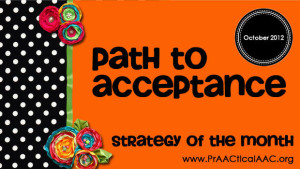
“Attitude is a little thing that makes a big difference”- Winston Churchill October’s Strategy of the Month focuses on Acceptance of AAC. There is always a path to acceptance of new ideas, new situations, or even new science. Even though AAC strategies and concepts are by no means new, they are often different from the ‘norm’ (whatever that is). We know that the path to acceptance is often filled with obstacles. In AAC, The Participation Model (Beukelman & Mirenda, 1988) delineates two main barriers to successful implementation. There are opportunity and access barriers. Opportunity barriers to participation are those imposed by people in the environment of the AAC user, while access barriers are present based on issues related to the individual who uses AAC. It seems that in the last several school and community visits, we have noticed a high degree of opportunity barriers which relate to attitude. The attitude... [Read More...]
Filed under: Strategy of the Month
Tagged With: AAC Acceptance, AAC Awareness, myths
October 6, 2012
by Carole Zangari -
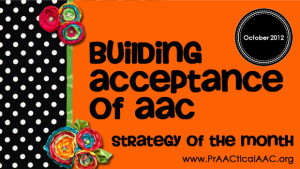
Since October is AAC Awareness Month, we wanted to focus on a topic that applies to everyone. No matter what age group or client population you work with, no matter what the service delivery setting is, you probably find yourself needing to build acceptance for implementation of AAC tools and strategies. So this month we’ve decided to share strategies for helping others see things the AAC way. We’ll talk about strategies for attitudinal, knowledge, and access barriers. To get us started, we consider a medical scenario in which Catherine visits her doctor, complaining of a sore throat. To determine the treatment, the physician first tries to identify the cause of Catherine’s discomfort and looks for the most common causes of sore throat. Allergies, infection, vocal abuse. Each cause triggers different treatment options for considerations. Antibiotics for allergies? Not likely to be effective. Antihistimines for vocal abuse? Nope. Knowing the root... [Read More...]
Filed under: Strategy of the Month
July 28, 2012
by Robin Parker -
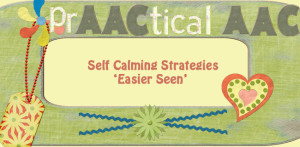
Throughout this month we focused on visual supports & strategies for positive behavior. We have discussed transition supports, environmental arrangements, and consequence mapping. As we wrap up, we don’t want to forget PrAACtical AAC strategies for self-calming. We like to think about self-calming like this- some weeks we need it more than others, some days we need it more than others. We all need self- calming strategies. Whether we vent to a friend, go for a run, knit, take deep breaths, or get a glass of wine (although we are not advocating this), we all use self-calming strategies. It makes a huge difference. Sometimes though helping our students self-calm at times may seem “easier said than done”, but we know it truly is ‘easier when SEEN‘. Self-calming strategies can help before, during, and after behavior challenges . We will often teach and use self calming strategies if we know a potentially stressful situation will... [Read More...]
Filed under: Strategy of the Month
Tagged With: Challenging Behavior, resources, Self-Calming, strategies, visual supports
July 21, 2012
by Carole Zangari -
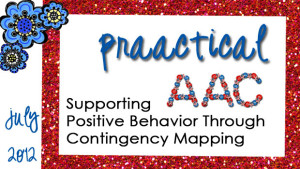
This month we’re focusing on visual supports and strategies to support positive behavior. We’ve talked about transition supports and environmental arrangements. Another way to help therapy sessions run smoothly and keep the focus on learning (rather than managing behavior) is to take proactive steps to make the expectations clear. For most people who are learning AAC, that means making sure there is a visual representation that accompanies the verbal explanation. – Many SLPs create a list of rules for expected behavior. In this post, we’ll talk about the research-supported strategy of using contingency maps. Contingency maps are a visual depiction that shows the desired behavior and the outcomes of two divergent paths: one where the learners engage in the desired behavior and the other that shows what happens if they don’t engage in the desired behavior. If you’re familiar with behavioral approaches, this strategy is right up your alley. The... [Read More...]
Filed under: Strategy of the Month
Tagged With: ASD, behavior, contingency map, developmental disability, intellectual disability, positive behavior support, visual supports
July 14, 2012
by Robin Parker -
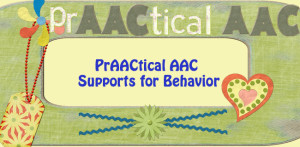
Our July Strategy of the Month, PrAActical AAC Supports for Behavior, is a favorite topic for us, because with a little planning, we can adhere to the old adage that an ‘ounce of prevention is worth a pound of cure’ (as Carole said last week). We also find that behavior challenges are often one of the main reasons, our students (and colleagues) get stressed about working with children with significant communication impairments. And since stress for ANYONE does not make for an optimal learning environment, we love to show how effective preventative strategies work. This week we are focusing on ‘setting the stage’ for conventional and appropriate behavior by engineering the physical environment. We are talking about more than keeping the room neat, clean, and generally organized. We are talking about arranging the physical environment in a planned and careful way in order can make a huge difference in helping... [Read More...]
Filed under: Strategy of the Month
Tagged With: behavior, behavior management, visual supports
July 7, 2012
by Carole Zangari -
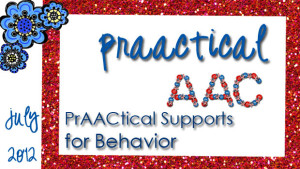
Rachel arrives to therapy tense and upset. Mauro gets frustrated when the clinician presents new activities. Brianna starts to bang the table when demands are placed on her. Zach becomes agitated when he has to wait for something he wants. – Like any set of tools and strategies, AAC works best when the communicator is relaxed, confident, and engaged. Our July Strategy of the Month focuses on PrAACtical Supports for Behavior. We hope to share ideas for planning therapy sessions that help AAC learners stay focused, calm, and engaged. — We’re big believers in the old adage that an ounce of prevention is worth a pound of cure. So, what can we do to prevent or minimize problems like the ones experienced by Rachel, Mauro, Brianna, and Zach? The answers have to do with having clear and appropriate expectations, and using visual and AAC supports effectively. When used consistently, these strategies... [Read More...]
Filed under: Strategy of the Month
Tagged With: aided language input, ASD, behavior, countdown board, developmental disability, first then, intervention, picture schedule, positive behavior support, transition, visual supports
June 23, 2012
by Robin Parker -
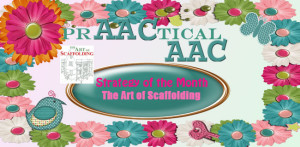
“The best thing about being a teacher is it matters. The hardest thing is that it matters every day. All the time.” Todd Whitaker (Just substitute SLP’s for teachers since SLP’s are teachers of communication and language) As June ends and we finish up with our Strategy of the Month: Language Facilitation Strategies, we do not want to move on without talking about scaffolding. We often use scaffolding without even knowing we are doing it, but for speech-language pathologists, we need to know the name of each strategy we use because that allows us to make the most of everything we say and do when teaching communication and language. Also, when we know what we are doing, we can teach it to communication partners and thus set the stage for language learning at home, in school, and in the community. What is it? Scaffolding is a verbal and visual strategy... [Read More...]
Filed under: Strategy of the Month
Tagged With: Graphic Organizers, language facilitation strategy, Scaffolding
June 16, 2012
by Carole Zangari -
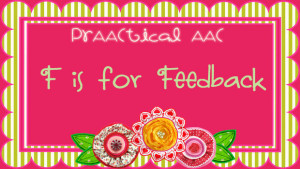
This month we’ve been talking about ways to use traditional language facilitation strategies with people who use AAC. So far, we’ve covered expansion and extensions and recasts. This week we talk about feedback. Feedback is a critical component of any learning experience. It functions as a signpost and let’s us know where we are relative to our destination. Let’s think about how we can use it to improve the language of people who use AAC. – Contingent Responses What we do and say after the AAC learner communicates can be a powerful way to impact patterns of language use. The cardinal rule in AAC intervention is to provide consequences that are contingent on what was communicated. So, if the beginning AAC learner requested a something they don’t really like by mistake, we’d still provide that item and have them interact with it briefly before giving them a chance to make a different choice.... [Read More...]
Filed under: Strategy of the Month
Tagged With: intervention, language
June 9, 2012
by Robin Parker -
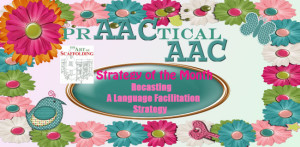
“Strategies Are The Secret To Learning” Tony Robbins There are many ways to teach speech and language but we think it is important to remember that the goal should be to teach spontaneous language. So all the strategies we discuss will be part of a responsive conversational style and be real or authentic to conversation. They will be for the facilitator (most often the adult) to use. There should be a purpose or strategy applied to each and every thing we communicate or ‘say’ when teaching language. This extra ‘dose’ of language facilitation is what transitions ordinary talking or language stimulation to specific language teaching/ or speech-language intervention. At the beginning of the month, we introduced language facilitation strategies by talking about aided language input, which is an authentic way of adding visual language and AAC modeling to the conversation. This week we are talking about RECASTS. Recasts serve to add or... [Read More...]
Filed under: Strategy of the Month
Tagged With: communication, language, language facilitation strategy, recasts









